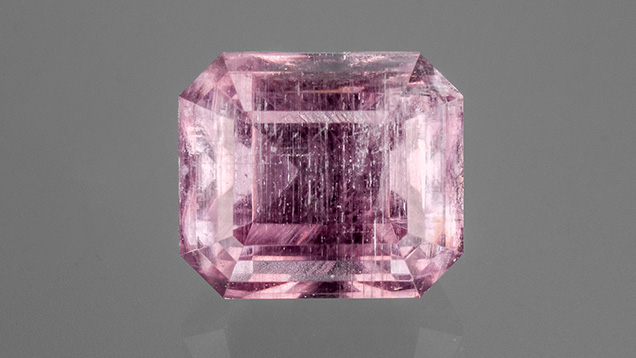Purple Anhydrite

Recently, the Carlsbad laboratory received a 2.13 ct transparent purple octagonal step cut, measuring 7.32 × 6.34 × 6.01 mm (figure 1), for a colored stone identification service. Microscopic observation showed twinning planes, cleavage cracks, needle-like inclusions, fluid fingerprints, and strong doubling of many internal features, confirming the stone was doubly refractive (figure 2).

Standard gemological testing revealed a specific gravity of 2.97 and a refractive index of 1.570–1.615 with a birefringence of 0.045. The refractive index measurement also indicated the stone was biaxial positive, and a biaxial interference figure was resolved using a conoscope and polarized light. Purple and light purple pleochroism was observed using a dichroscope. The specimen had no fluorescence reaction when exposed to long- and short-wave UV light. These characteristics were consistent with the rare collector gem anhydrite.
Raman spectroscopy confirmed that the stone was anhydrite. Using polarized ultraviolet/visible/near-infrared spectroscopy, we were able to determine that the purple color resulted from a prominent absorption band centered at around 550 nm. A sharp absorption feature was also observed at 307 nm.
Anhydrite is a calcium sulfate with the chemical formula CaSO4. It is not well suited for use in jewelry due to its low hardness of 3.5 on the Mohs scale and its perfect cleavage in one direction. This orthorhombic mineral is commonly formed by the dehydration of gypsum, which has the chemical formula CaSO4•2H2O, and can have multiple colors ranging from colorless to pale blue, light pink, and brown that is colored by impurities. Occurrences of purple anhydrite have been reported in Switzerland, Iran, and Sri Lanka (see, respectively, Spring 1998 Gem News, p. 60; Fall 2000 Gem News, p. 262; Fall 1988 Gem News, p. 179).
Faceted gem-quality and single-crystal anhydrite is rare, and while the Carlsbad laboratory has examined a couple of anhydrite gems, they were mostly aggregates bluish in color. This is the first example of a transparent purple faceted single crystal anhydrite examined at GIA’s Carlsbad laboratory.



